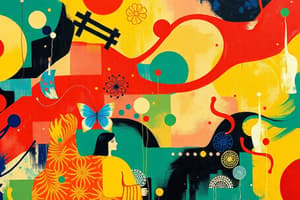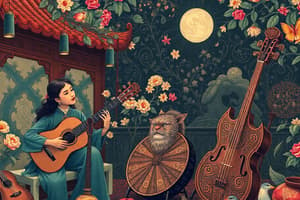Podcast
Questions and Answers
What does Sakura depict?
What does Sakura depict?
- Autumn, the season of falling leaves
- Spring, the season of cherry blossoms (correct)
- Winter, the season of snow and cold
- Summer, the season of sunshine and warmth
What is the meaning of Mo Li Hua in Chinese?
What is the meaning of Mo Li Hua in Chinese?
- Rose flower
- Chrysanthemum flower
- Jasmine flower (correct)
- Lotus flower
What does the term Chong-ak refer to in Korean music?
What does the term Chong-ak refer to in Korean music?
- Folk music for the general public
- Ensemble music for men of high social status (correct)
- Vibrant and energetic music
- Music for the lower classes
What is Odaiko in Japanese music?
What is Odaiko in Japanese music?
What type of music is Pansori in Korea?
What type of music is Pansori in Korea?
What distinguishes Korean Music from classical music works?
What distinguishes Korean Music from classical music works?
Which Japanese instrument is similar to a guitar or banjo with 3-4 strings?
Which Japanese instrument is similar to a guitar or banjo with 3-4 strings?
What is the chosen instrument of "BENTEN" the goddess of music, poetry, and education in Japanese Shinto?
What is the chosen instrument of "BENTEN" the goddess of music, poetry, and education in Japanese Shinto?
Which Korean instrument has a 2 string vertical fiddle held vertically on the knee of the performer and played with a bow?
Which Korean instrument has a 2 string vertical fiddle held vertically on the knee of the performer and played with a bow?
What does the Chinese instrument 'Yunluo' consist of?
What does the Chinese instrument 'Yunluo' consist of?
Which instrument is literally known as the "Dragon Flute" and used in bagaku?
Which instrument is literally known as the "Dragon Flute" and used in bagaku?
What is the most famous flute made from bamboo in Japan?
What is the most famous flute made from bamboo in Japan?
Flashcards
Sakura Symbolism
Sakura Symbolism
Sakura, the Japanese cherry blossom, represents renewal, beauty, and the fleeting nature of life.
Chong-ak
Chong-ak
Korean 'refined music', usually associated with Joseon Dynasty court performances.
Odaiko
Odaiko
Large Japanese drum, powerful sound, often used in festivals and performances
Pansori
Pansori
Signup and view all the flashcards
Shamisen
Shamisen
Signup and view all the flashcards
Biwa
Biwa
Signup and view all the flashcards
Haegeum
Haegeum
Signup and view all the flashcards
Yunluo
Yunluo
Signup and view all the flashcards
Ryuteki
Ryuteki
Signup and view all the flashcards
Shakuhachi
Shakuhachi
Signup and view all the flashcards
Korean Music
Korean Music
Signup and view all the flashcards
Study Notes
Sakura in Art and Culture
- Sakura, the Japanese cherry blossom, symbolizes renewal, beauty, and the ephemeral nature of life.
- It represents the transience of life and the importance of appreciating its fleeting moments.
- Sakura is a popular motif in Japanese art, literature, and culture, often associated with springtime and festivals.
Mo Li Hua
- Mo Li Hua translates to "Jasmine Flower" in Chinese.
- It is a popular folk song in China and is known for its beautiful melody and lyrics that celebrate the beauty of jasmine flowers.
- The song often symbolizes love, purity, and the joy of life.
Chong-ak
- Chong-ak refers to "refined music" or "high-class music" in Korean traditional music.
- It was developed during the Joseon Dynasty and is characterized by its use of elaborate melodies and complex rhythms.
- Often performed by court musicians and at royal ceremonies, Chong-ak reflects the elegance and grandeur of the Joseon court.
Odaiko
- Odaiko is a type of large Japanese drum used in traditional Japanese music.
- It is known for its powerful sound and is often used in festivals, ceremonies, and performances.
- These drums are typically made from a single piece of hollowed-out wood and are struck with large wooden mallets.
Pansori
- Pansori is a form of Korean musical storytelling that combines singing, acting, and percussion.
- Performances are typically a dramatic solo with narration, accompanied by a single percussionist (gosu).
- Pansori narratives often center around legendary heroes, tragic love stories, and societal struggles.
Korean Music vs. Classical Music
- Korean music, while sharing some characteristics with Western classical music, is distinct in its emphasis on melodic patterns and rhythmic structures.
- Korean music often incorporates pentatonic scales and complex rhythmic patterns that differ from those found in Western classical music.
- Instruments like the gayageum and geomungo are unique to Korean music, contributing to its distinctive sound.
Shamisen
- The Shamisen is a traditional Japanese stringed instrument similar to a guitar or banjo.
- It has a long fretless neck, a hollow body covered with snakeskin, and typically 3-4 strings.
- The Shamisen is mainly used in Kabuki theater and other traditional Japanese music genres.
Biwa
- The Biwa is a Japanese instrument that is associated with the goddess of music, poetry, and education, Benten.
- It's a four-stringed lute-like instrument with a long neck and a rounded body.
- Often used in religious rituals and traditional music performances, the Biwa is said to possess a mystical and spiritual quality.
Haegeum
- The Haegeum is a two-stringed vertical fiddle that is held knee-high and played with a bow.
- It's a common instrument in Korean traditional music, known for its melodic and expressive capabilities.
- Its unique construction and playing style evoke a haunting and lyrical sound.
Yunluo
- The Yunluo is a Chinese instrument that consists of a set of tuned bells hanging on a wooden frame.
- The bells are struck with a mallet to create a variety of sounds and patterns.
- The Yunluo is typically used in traditional Chinese music and theatrical performances.
Dragon Flute in Bagaku
- The Ryuteki, literally known as the "Dragon Flute", in Japanese, is a vertically held bamboo flute used in bagaku, a form of ancient court music.
- Its distinctive design and its resonant sound create a celestial and ethereal feeling in performances.
- The Ryuteki's popularity in ceremonial and spiritual music connects its use closely with Japanese folklore and traditional beliefs.
Shakuhachi
- The Shakuhachi is a Japanese bamboo flute with a unique, haunting sound and is considered the most famous bamboo flute in Japan.
- Traditionally used in Zen Buddhist rituals, the Shakuhachi is now also a popular instrument in contemporary music genres.
- Its ability to produce a range of sounds, from gentle melodies to powerful tones, has contributed to its popularity worldwide.
Studying That Suits You
Use AI to generate personalized quizzes and flashcards to suit your learning preferences.




